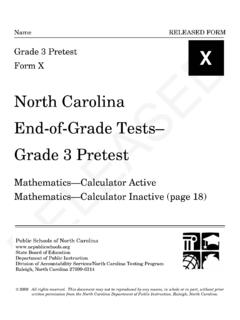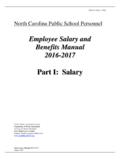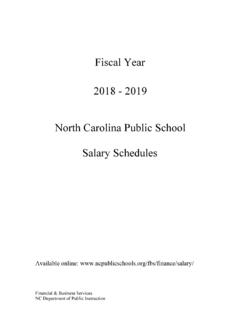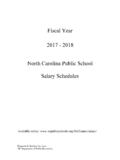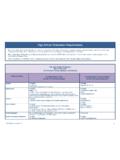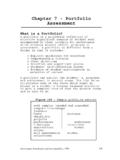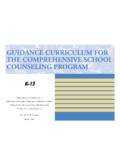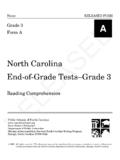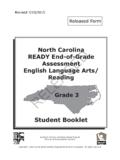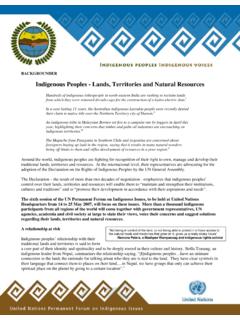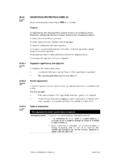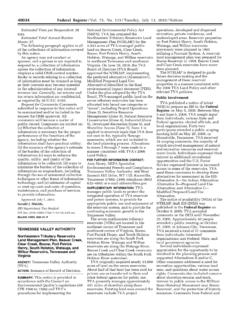Transcription of Activities and Teaching Strategies for Secondary …
1 PERSONAL FINANCIAL LITERACY: Activities and Teaching Strategies forSecondary social StudiesPUBLIC SCHOOLS OF NORTH CAROLINAS tate Board of EducationDepartment of public Instruction Financial Literacy Secondary Education Division North Carolina Department of public Instruction 2006 1 Acknowledgements The North Carolina Department of public Instruction would like to thank the following educators for their work on this document. Pamela Finlayson, Charlotte-Mecklenburg Schools Leslie Martin, Winston-Salem Forsyth Schools Heather Vinson, Wake County Schools Any questions regarding this document can be addressed to: Judy U.
2 McInnis High School social studies Consultant Department of public Instruction (919) 807-3924 Steven M. Weber High School social studies Consultant Department of public Instruction (919) 807-3828 Financial Literacy Secondary Education Division North Carolina Department of public Instruction 2006 2 The need to strengthen, expand and enhance education in economics and personal finance in our nation s schools has never been more apparent. We must prepare our students with the basics of economic and financial literacy so that they can succeed in life.
3 This literacy, together with reading and mathematics, is key to home ownership, being a smart consumer, managing credit, financing higher education, saving and investing, and responsible citizenship. - Dr. Robert F. Duvall, President and CEO National Council on Economics Education (NCEE) Introduction Personal Financial Literacy legislation in North Carolina states that Both the North Carolina Standard Course of Study and the Basic Education Program shall include the requirements that the public schools provide instruction in personal financial literacy for all students during the high school years.
4 1 Personal Financial Literacy: Activities and Teaching Strategies for Secondary social studies was created by the North Carolina Department of public Instruction and high school teachers in an effort to support high school teachers in their instruction. In the following pages, educators will find lessons and units of study which will enhance student understanding of key economic concepts. The Teaching of personal finance enhances the curriculum and equips students with essential life skills. This document includes lessons on economic basics, taxing and spending, money management, savings and investment, credit, insurance, and banking. Personal Financial Literacy: Activities and Teaching Strategies for Secondary social studies provides educators with a foundation for Teaching personal financial literacy to high school students.
5 Teachers are encouraged to utilize the educational resources which are provided at the end of this document, as they continue to prepare students with life skills for the 21st century. 1 Teach Financial Literacy In public Schools 115C-81 as amended by Session Law 2005-276, Section Financial Literacy Secondary Education Division North Carolina Department of public Instruction 2006 3 Table of Contents Introduction Section I - Economic The Four Factors of Production and their Candy Bar Section II - Taxing and Local Taxes: Where Does All The Money Go?
6 23 State Taxes: Why Do We Pay the State?..28 Economic Investment in a Community: A Case Is There Such a Thing as a Good Tax?..40 Section III - Money Dream Family Financial Section IV - Savings and Investment: Does Money Grow?..98 Section V Credit: Friend or Foe?..114 Read the Fine Section VI Insuring Against Insurance: Do We Need It?..147 Section VII Banks and Consumer No Rubber Additional Financial Literacy Secondary Education Division North Carolina Department of public Instruction 2006 4 North Carolina Standard Course of Study The following objectives are included in the lesson plans and Strategies for Teaching Personal Financial Literacy.
7 Each lesson is aligned with the North Carolina Standard Course of Study for Civics and Economics. These lessons can be taught in other social studies courses, elective courses and even across disciplines. OBJECTIVES Examine taxation and other revenue sources at the state and local level. Describe the services provided by state and local government agencies and how funding is provided. Describe the basic factors of production such as land, labor, capital, and entrepreneurial skills and their impact on economic Activities . Explain how scarcity influences producers and consumers to make choices. Compare examples of tradeoffs and opportunity costs of economic choices.
8 Analyze the impact on economic Activities of specialization, division of labor, consumption and production increases. Explain the impact of investment on human, capital, productive, and natural resources. Financial Literacy Secondary Education Division North Carolina Department of public Instruction 2006 5 Describe how the free enterprise system encourages private ownership of property and promote individual initiative. Evaluate the investment decisions made by individuals, businesses, and the government. Describe the role of money in trading, borrowing, and investing.
9 Explain the impact of the movement of human and capital resources on the United states economy. Assess how current events impact decisions made by consumers, producers, and government policy makers. Analyze the short- and long-term effects of fiscal and monetary policy on the United states economy. Analyze the influence of environmental factors, economic conditions, and policy decisions on individual economic Activities . Evaluate the importance of supporting, nurturing, and educating oneself in the United states society. Demonstrate characteristics of effective citizenship. Describe examples of recurring public problems and issues. Financial Literacy Secondary Education Division North Carolina Department of public Instruction 2006 6 Economic literacy is crucial because it is a measure of whether people understand the forces that significantly affect the quality of their lives.
10 - Gary H. Stern, President Federal Reserve Bank of Minneapolis Section I Economic Basics Financial Literacy Secondary Education Division North Carolina Department of public Instruction 2006 7 The Four Factors of Production and Their Rewards Students often understand the concept of scarcity as it relates to not enough of something. The jump to understanding the essential economic factors of production as the true scarce resources is often more difficult. The concept of resources that cannot be replaced is more challenging, but basic to a broad understanding of economics.
